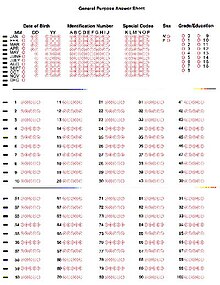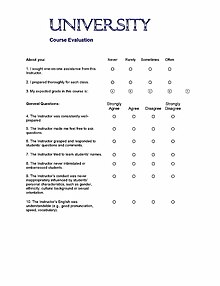Optical mark recognition
The OMR software then works with a common desktop image scanner with a document feeder to process the forms once filled out.A related field to OMR and OCR is the recognition of barcodes, such as the UPC bar code found on product packaging.One of the most familiar applications of OMR is the use of #2 pencil (HB in Europe) bubble optical answer sheets in multiple choice question examinations.Bar codes may mark the sheet for automatic processing, and each series of ovals filled will return a certain value when read.The slight difference was not apparent to the naked eye, and was not detected until a test run was made in late October.This required all ballots to be transferred to correctly printed ones, by sequestered workers of the board of elections, under close observation by members of the Democratic and Republican (but not other) political parties, and county sheriff deputies.[citation needed] OMR software is a computer software application that makes OMR possible on a desktop computer by using an Image scanner to process surveys, tests, attendance sheets, checklists, and other plain-paper forms printed on a laser printer.While data capturing scanning devices focus on many factors like thickness of paper dimensions of OMR sheet and the designing pattern.The first successful optical mark-sense scanner was developed by Everett Franklin Lindquist as documented in US Patent 3,050,248 (filed in 1955, granted in 1962).The rights to Lindquist's patents were held by the Measurement Research Center until 1968, when the University of Iowa sold the operation to Westinghouse Corporation.During the same period, IBM also developed a successful optical mark-sense test-scoring machine, as documented in US Patent 2,944,734 (filed in 1957, granted in 1960).These applications included a variety of inventory management and trouble reporting forms, most of which had the dimensions of a standard punched card.OMR, OCR, and ICR technologies all provide a means of data collection from paper forms.Progress in OMR now allows users to create and print their own forms and use a scanner (preferably with a document feeder) to read the information.[19] OMR systems approach one hundred percent accuracy and only take 5 milliseconds on average to recognize marks.[18] As a result of the widespread adoption and ease of use of OMR, standardized examinations can consist primarily of multiple-choice questions, changing the nature of what is being tested.




OMR devicesscannerreflectivitysoftwarelaser printerdocumentoptical character recognitionpattern recognitionbarcodesUPC bar code#2 penciloptical answer sheetsexaminationsUnited StatesEuropeanOMR machinesoptical answer sheetambiguitypopularenvelopeScantron CorporationBar codesphototubesvisible spectrumtransmitgraphiteopaquehuman error2008 U.S. presidential electionabsentee ballotsGeorgiaGwinnettnaked eyeballotsboard of electionsobservationDemocraticRepublicansheriffdeputieselection dayImage scannercensusbitonalgrayscalepaper tapepunch cardsmark senseIBM 805 Test Scoring MachineEverett Franklin LindquistUniversity of IowaWestinghouse Corporationpunched cardScantronPearson Educationdata collectionJapan Racing AssociationFukushima Racecourseinstitutional researchTests and assessmentsTime sheetsLotteriespostal codesMortgage loanBooleanaccuracymillisecondsstandardized examinationsAI effectApplications of artificial intelligenceClock markElectronic data captureObject recognitionBenjamin D. WoodList of emerging technologiesOutline of artificial intelligencePaper data storageWritingpapyrusIndex cardPunched tapeEdge-notched cardBarcode